Day 8: Ilion to St. Johnsville
Wednesday, August 11, 1999
Trains went by frequently during the night and during the morning, but
they didnít bother us. The marina was very nice. I took a shower.
It started raining when we got up. I moved my chair
to the stern of the steamboat, so we had an intimate breakfast of Cheerios
in the rain.
We walked to town to see the museum at the Remington Arms Company and
to take an interesting tour of the plant. The cars in the parking
lot were mostly pickup trucks. The plant is huge, covering thirty-six
acres. Much of the equipment in it is rather antiquated. The
plant has been in business there for about 175 years, which, not coincidentally,
is the same as the existence of the Erie Canal. They make about half
a million guns a year.
We got the fire going and were our way about 10:35 a.m.
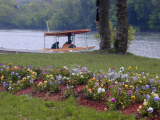 |
Flowers and the Aurora Borealis at the Ilion Village Marina. | |
 |
The Remington plant. |
|
At Lock 18 (lift 20.0 feet) near Jacksonburg, we had to wait for the lock
to fill for a westbound boat, then took a while going down. The lines
at the side of the lock were short and Al couldnít let go. The boiler
got full of water and the engine did, too, so he had to blow down several
times as we left the lock.
We were startled to see a sign informing us of construction work and
warning us to be prepared to stop. Before us lay a floating bridge
traversing the entire canal with trucks driving across it! What do
we do? As we got closer, some of the floating bridge was moved to
the side and we were able to get through.
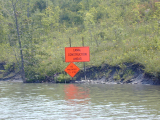 |
Construction sign. | |
 |
Truck driving across floating bridge. |
|
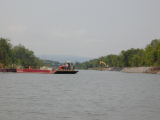 |
The bridge closing behind us. | |
 |
Closed again. |
|
We were now definitely in the Mohawk River Valley, with hills surrounding
us.
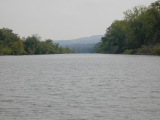 |
The Mohawk River valley. | |
 |
Satisfied captain. |
|
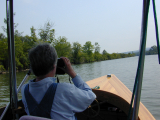 |
Checking out the aids to navigation (red on port; green on starboard)...and steering. | | |
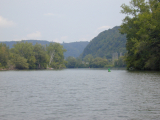 |
Entering Little Falls. | |
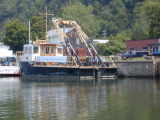 |
School boat. |
|
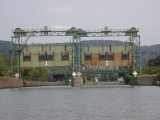 |
Double guard gate above Lock 17 at Little Falls. | |
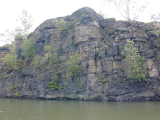 |
The type of hard rock that causes the falls to exist. |
|
A big event of the day was visiting Lock 17 (lift 40.5 feet) at Little
Falls, where we were to pick up our load of wood. Mark Rinkerman
was on duty as lockmaster. He let us move into the lock. We loaded
wood using a wheelbarrow, ending up with a very full boat. The sailboat
La Vie Dansant, with which we had been leapfrogging for several days, entered
the lock just as we were finishing loading the wood.
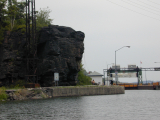 |
Note rock climbers on the hard rock. | |
 |
Entering Lock 17. |
|
 |
Loading wood. | |
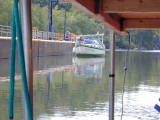 |
La Vie Dansant. |
|
 |
A boatfull of wood. | |
 |
The gate in front of us. |
|
Lock 17 used to be highest lift lock in the world. The advent of the St.
Lawrence Seaway made it lose that distinction, but it is still one of the
highest.
At any rate, itís a long way down! The huge lower counterbalanced
gate rises and falls vertically. I tried to take pictures with one
hand as I held onto the lock line with the other hand. Turn the camera
on. Adjust the field of view. Try to hold the camera vertical
and keep the lens cap out of the way. Find the shutter release button
and try to shoot a picture. In the meantime, Al was calling for me
to push the steamboat further away from the wall: there was a little leak
in the lock wall that let loose a parabola of water which peed into the
boat. Anyway, we survived.
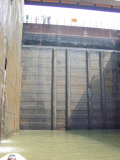 |
The gate shut. | |
 |
Starting to rise. See the curtain of water. |
|
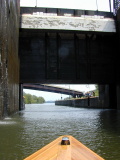 |
Rising furtherÖ. | |
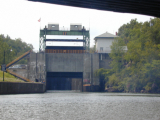 |
Looking back upstream. |
|
This was with no fire going (since it was going to take us so long), so
we spent a while below the lock getting started again. Mark called
to us on the VHF to make sure we were okay.
The Mohawk rejoined the canal here and our waterway became much wider.
 |
Whistle, gauge, and stack. |
We were perking right along when we passed the Herkimer Home on the
south side of the river. There was a nice dock there and a pathway
up from the river. I said I wanted to stop. We visited the
museum, saw a slide show, and took a tour of the Herkimer Home. Nicholas
Herkimer owned the portage around Little Falls. Since he charged
tolls for the portage, he became the wealthiest of the Palatines settling
in the Mohawk Valley. (At an earlier time, the Mohawks had
controlled the portage arund the falls, giving them power in the Iroquois
Confederacy.) Herkimer built his home in 1752. He had
been a captain of the militia during the French and Indian wars and was
a general in the Battle of Oriskany during the Revolutionary war.
He died of a leg wound after having had his leg badly amputated.
About 100 feet north of the home was an old railroad bed and not very
many feet from that was the site of the old and enlarged Erie Canal.
(This was between our dock and the home).
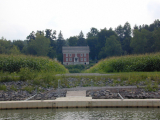 |
The Herkimer Home. | |
 |
The garden at the Herkimer Home. |
|
A couple of miles upstream from Lock 16, we encountered a boat going upsteam.
It radioed to the lockmaster that a steamboat would be there in about ten
minutes.
Just before the lock are the remains of a lock from the Enlarged
Erie Canal.
At Lock 16 (lift 20.5 feet) at St. Johnsville, the lockmaster asked
if we had been having any trouble. He had been expecting us and when
we didnít show up, he asked the boat that was going upstream to look for
us. We explained that we had stopped at the Herkimer Home.
We have appreciated the lockmastersí concern in watching out for us.
We docked at the St. Johnsville Marina. Since we wanted electricity
for recharging batteries, we had to tie up to a high terminal wall.
We docked near a ladder by the pumpout station so we could get out.
 |
Aurora Borealis dwarfed by the wall. |
A man from the marina drove us two miles to an inexpensive and good
Italian-American restaurant named Merimerís and a person from the
restaurant drove us back. That was a nice transportation service
to enjoy. Al had haddock and I had ham, plus a salad bar and good
bread. Back at the marina, Al enjoyed a shower.
Mosquitoes did little to keep us awake.
Number of locks: 3
Approximate distance for day: 22 miles
Next day Previous
day Steamboat trip index



